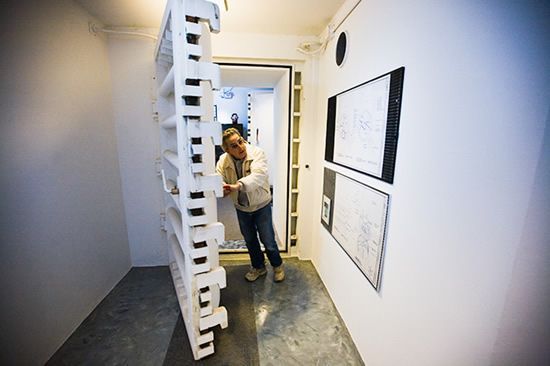

“It’s epoxy concrete and 600 tons of rebar,” he said. Louis to Chicago. The construction site resembled an open pit mine. The government built the silo in about a year in 1960, using enough concrete to build a 12-foot-wide road from St. The first level of the space housed the staff while they were on their shift, including bedrooms, bathrooms with a shower, a kitchen, and a recreational area, while the second floor held all the controls. The doors protected the people inside the facility from blasts and any potential intruders. The hallway leading to the underground area was built in a zigzag pattern so that in the event of an attack, the blast would force the front door into a wall instead of hitting the people and technology inside.īefore the actual control center are two 7,000-pound doors that open to the steps leading into the launch control center. “Just like the electricity, we didn’t get too extensive because they’re not going to keep it this way.” Living deep underground “The thing is, people here are going to build it the way they want,” he said. Novitzke also emphasized their goal for the project was to get every part to be a blank slate and usable for whoever comes in next. In the summer, the highest temperature it reaches is 72. The temperature helped, as the coldest it ever got was around 60 degrees. He said the underground space weathered well over time. Novitzke also set up power and drinkable water. There is a lot of need for this type of property.They made it easier to breathe, cleaned out the water, installed lighting and a septic system, and scraped away the leeching and seepage that developed from decades without use. “ some kind of freaky, end-of-the-world, zombie-apocalypse whatever. Lunn stresses these are regular homes where people would be very comfortable living or vacationing. “That’s really one of those tips of the trade for guys that are building bunkers.” “Any bunker worth its salt has to have those 90-degree turns, because nuclear and chemical material can’t go around ,” Lunn explains. Upon entry, the hallway takes a turn at a right angle. The homes are currently attached to the electrical grid, but could be unhooked if a buyer decided to rely on the property’s own generators for power.Īs in the case of most fallout shelters, the entrance to each home is through a thick door. “If our great-grandparents didn’t prep, none of us would be here,” she says. But she acknowledges that that is basically what people do when they store supplies in underground bunkers. The agent says she doesn’t like to use the term “preppers,” because of the negative connotations attached to the term.

Lunn says buyers have shown an interest in the property-ranging from those in search of a sustainable property, to folks who desire the ultimate in protection. It’s also a great retreat possibility.” Bathroom “If you bought this, you could live in it and still rent it out. “It’s a great spot for vacation rentals,” Lunn says, adding that renting an underground home could offer a unique allure for guests. It’s a huge mecca for fly fishermen,” Lunn says, adding hunting, hiking, snowmobiling, four-wheeling, and horseback riding are also popular. “It’s arguably one of the most beautiful places in the U.S., for sure. The Paradise Valley area is known for its outdoor activities. He is offering that as a buyer package, if someone wanted that.” Hallway “The additional house has not been built. Underneath the house, it would have a discrete entrance into shelter No. “He would put a very nice home for an extra $240,000 onto the list price. The current owner is a builder and is willing to sweeten the deal for a buyer who might be interested in buying the land and the underground homes. One house features a pool table in the rec room. “You walk down hallways, but then you just you walk into a kitchen that you think is your mom’s kitchen-a great area, bedrooms, very nice bathrooms.” It’s just like you’re in a house,” Lunn explains. “Once you’re in there, they’re comfortable. ExteriorĮach home comes with its own kitchen, complete with appliances. “It never feels musty in there with the air circulation system. The earth keeps the houses at a constant 50 to 55 degrees and to increase the temperature as needed, each home is equipped with its own HVAC and ventilation system.


 0 kommentar(er)
0 kommentar(er)
